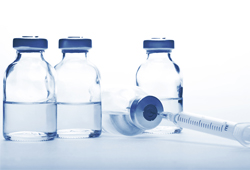Down Rounds 101
 Private life sciences companies looking to raise funds in the current environment might face the prospect of a “down-round” – a financing round at a lower pre-money valuation than the post-money valuation in prior round(s). “Down-rounds” raise various risks and considerations for both companies and investors.
Private life sciences companies looking to raise funds in the current environment might face the prospect of a “down-round” – a financing round at a lower pre-money valuation than the post-money valuation in prior round(s). “Down-rounds” raise various risks and considerations for both companies and investors.
“Down-rounds” affect both ownership percentage and value of shares, and typically trigger antidilution protections, which would increase the conversion price/ratio such that existing investors would receive more Common Stock for each share of Preferred Stock, based on the formula in the company’s Certificate of Incorporation.[1] Companies should carefully calculate and evaluate the effects of “down-rounds” on their capitalization and related thresholds for various requisite approvals. Following “down-round” financing, the conversion prices should be reset to reflect any adjustments.
Companies can encourage existing investors to participate (and, potentially, avoid “down-round”) by offering senior preference (ahead of prior liquidation preferences), adding a multiple liquidation preference (e.g. 2x instead of 1x), and/or introducing mechanics that would further dilute non-participating investors or even convert Preferred Stock of such investors to Common Stock, such as pay-to-play, cram down (by stock splits or conversion ratio modifications) or pull up (by converting the outstanding preferred stock of participating investors to the new preferred stock).
Careful consideration should be given to fiduciary duties of controlling stockholders and of directors, in particular those representing existing investors who participate in a “down-round,” since “Interested party” transactions are not afforded the benefit of the business judgment rule, and may face liability for such financings under the “entire fairness” standard. Due process matters, and adopting practices (to the extent possible) can mitigate potential risks. Customary and advisable practices include a board committee of disinterested directors, consent of a super-majority of the stockholders, offering all stockholders the right to participate in the financing through a rights offering, soliciting outside investors and obtaining a third-party valuation or fairness opinion.[2]
_______________________________________________________________________________________
[1] Customary protections include: (i) full ratchet, which resets the conversion price to the price of new securities and is unfavorable to founders and, consequently, is rare; (ii) narrow based weighted average, which takes into account the share price and number of the new securities, the original issue price of existing shares and the number of outstanding shares, and counts fewer shares as outstanding; and (iii) broad based weighted average, which is the same as narrow based weighted average, but counts more shares as outstanding and is therefore less favorable to investors and results a smaller increase in conversion rates.
[2] For an overview of good practices see client alert https://www.goodwinlaw.com/publications/2020/04/04_28-dilutive-down-round-financings-in-the-us.

 For life sciences companies who are or are looking to become publicly traded in the U.S., one of the most frequent comments that we see from the SEC as part of their review process is the following:
For life sciences companies who are or are looking to become publicly traded in the U.S., one of the most frequent comments that we see from the SEC as part of their review process is the following: The UK Government has announced a new fund that provides financing to UK start-ups and scale-ups in the form of a convertible loan which is invested directly by the Government. For further detail on the fund please see: https://www.gov.uk/guidance/future-fund.
The UK Government has announced a new fund that provides financing to UK start-ups and scale-ups in the form of a convertible loan which is invested directly by the Government. For further detail on the fund please see: https://www.gov.uk/guidance/future-fund. As discussed in Goodwin’s prior Client Alert, on April 10, 2020, the U.S. Department of Health and Human Services (HHS) began disbursing $30 billion to Medicare providers and suppliers under the Public Health and Social Services Emergency Fund (PHSS Emergency Fund). HHS is requiring providers to agree to certain terms and conditions or return the payments. A number of the terms and conditions created some confusion as to whether providers who have not provided services directly related to COVID-19 may keep the payments. HHS has now clarified that providers may keep payments distributed under the PHSS Emergency Fund regardless of whether they have or will provide services directly related to COVID-19.
As discussed in Goodwin’s prior Client Alert, on April 10, 2020, the U.S. Department of Health and Human Services (HHS) began disbursing $30 billion to Medicare providers and suppliers under the Public Health and Social Services Emergency Fund (PHSS Emergency Fund). HHS is requiring providers to agree to certain terms and conditions or return the payments. A number of the terms and conditions created some confusion as to whether providers who have not provided services directly related to COVID-19 may keep the payments. HHS has now clarified that providers may keep payments distributed under the PHSS Emergency Fund regardless of whether they have or will provide services directly related to COVID-19. As the COVID-19 pandemic continues to unfold, U.S. public company compensation committees face unique challenges as they focus on retaining and appropriately incentivizing employees while evaluating the impact of the pandemic on the company. This client alert provides a high-level overview of some key issues that compensation committees should be focusing on in this environment.
As the COVID-19 pandemic continues to unfold, U.S. public company compensation committees face unique challenges as they focus on retaining and appropriately incentivizing employees while evaluating the impact of the pandemic on the company. This client alert provides a high-level overview of some key issues that compensation committees should be focusing on in this environment. On March 27, 2020, President Trump signed into law the Coronavirus Aid, Relief, and Economic Security (CARES) Act in response to the U.S. COVID-19 pandemic. Throughout the COVID-19 outbreak, there has been public discussion and concern over the availability and accessibility of critical medical devices, such as ventilators, and the pandemic has highlighted gaps in the U.S. Food and Drug Administration’s (FDA’s) authorities regarding medical product shortages. FDA has been able to collect information on drug shortages and take steps to help prevent or mitigate such shortages under authorities set forth in the Food and Drug Administration Safety and Innovation Act of 2012 (FDASIA). However, FDA had not, until now, had equivalent authority with regard to shortages of critical devices. Among the many provisions of the CARES Act (“the Act”) are amendments and additions to the Federal Food, Drug, and Cosmetic Act (FDCA) that give FDA the ability to effectively address such shortages. Additionally, the Act enhances FDA’s existing authority with respect to drug shortage measures. Below, we have highlighted the key provisions in these areas under the new law.
On March 27, 2020, President Trump signed into law the Coronavirus Aid, Relief, and Economic Security (CARES) Act in response to the U.S. COVID-19 pandemic. Throughout the COVID-19 outbreak, there has been public discussion and concern over the availability and accessibility of critical medical devices, such as ventilators, and the pandemic has highlighted gaps in the U.S. Food and Drug Administration’s (FDA’s) authorities regarding medical product shortages. FDA has been able to collect information on drug shortages and take steps to help prevent or mitigate such shortages under authorities set forth in the Food and Drug Administration Safety and Innovation Act of 2012 (FDASIA). However, FDA had not, until now, had equivalent authority with regard to shortages of critical devices. Among the many provisions of the CARES Act (“the Act”) are amendments and additions to the Federal Food, Drug, and Cosmetic Act (FDCA) that give FDA the ability to effectively address such shortages. Additionally, the Act enhances FDA’s existing authority with respect to drug shortage measures. Below, we have highlighted the key provisions in these areas under the new law. The Coronavirus Aid, Relief, and Economic Security Act (“CARES Act”), which was enacted on March 27, 2020, created new programs and expanded existing programs in ways that significantly affect the options for employers. This alert identifies key aspects of the CARES Act that can affect employers’ decisions in managing payroll costs during this challenging period. This alert also reviews other considerations for employers, including federal and state plant closing laws and Fair Labor Standards Act (“FLSA”) requirements. This alert focuses on considerations based on federal law and the laws of California, Massachusetts and New York.
The Coronavirus Aid, Relief, and Economic Security Act (“CARES Act”), which was enacted on March 27, 2020, created new programs and expanded existing programs in ways that significantly affect the options for employers. This alert identifies key aspects of the CARES Act that can affect employers’ decisions in managing payroll costs during this challenging period. This alert also reviews other considerations for employers, including federal and state plant closing laws and Fair Labor Standards Act (“FLSA”) requirements. This alert focuses on considerations based on federal law and the laws of California, Massachusetts and New York.